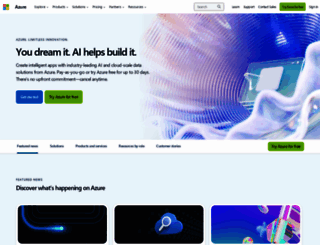Cloud Computing Services | Microsoft Azure
Page Load Speed
3.3 sec in total
First Response
69 ms
Resources Loaded
2.7 sec
Page Rendered
475 ms

About Website
Visit azure.com now to see the best up-to-date Azure content for United States and also check out these interesting facts you probably never knew about azure.com
Invent with purpose, realize cost savings, and make your organization more efficient with Microsoft Azure’s open and flexible cloud computing platform.
Visit azure.comKey Findings
We analyzed Azure.com page load time and found that the first response time was 69 ms and then it took 3.2 sec to load all DOM resources and completely render a web page. This is a poor result, as 55% of websites can load faster.